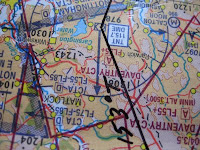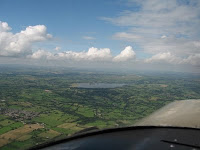
 Click on an image to ENLARGE.
Click on an image to ENLARGE.(Note: The chart is ORIENTATED in the direction of flight. Carsington Water is ahead & left.)
The Cross Wind (X-W) and X-wind Component (XWC) issues have been addressed, now we need to look at the Head Wind Component (HWC) & Tail Wind Component (TWC).
It has already been stated that, for practical purposes, the HWC can be considered as:
It has already been stated that, for practical purposes, the HWC can be considered as:
0˚ & 10˚, 20˚ & 30˚, 40˚, 50˚, 60˚, 70˚, 80˚ and 90˚ OFF the Required Track, where:
- 0˚ & 10˚ = 100%
- 20˚ & 30˚ = 90%
- 40˚ = 80%
- 50˚ = 60%
- 60˚ = 50%
- 70˚ = 30%
- 80˚ = 20
- 90˚ = 0%.
A 25kt wind from dead ahead or from 10˚ OFF will be 25kts of HWC. So:
- From 0˚ or 10˚ OFF the HWC will be 25kts
- From 20˚ or 30˚ OFF the HWC will be 22kts
- From 40˚ OFF will be 20kts
- From 50˚ OFF will be 15kts
- From 60˚ OFF will be 12kts
- From 70˚ OFF will be 8kts
- From 80˚ OFF will be 5kts
- From 90˚ OFF will be 0kts
- From 100˚ OFF will be 5kts TWC
- From 110˚ OFF will be 8kts TWC
Etc……………
Apply the HWC or TWC to the TAS and you will have the GROUNDSPEED (GS).
Note: These calculations are not meant to replace flight planning. The idea is to facilitate quick and reasonably accurate mental reckoning in flight.

No comments:
Post a Comment